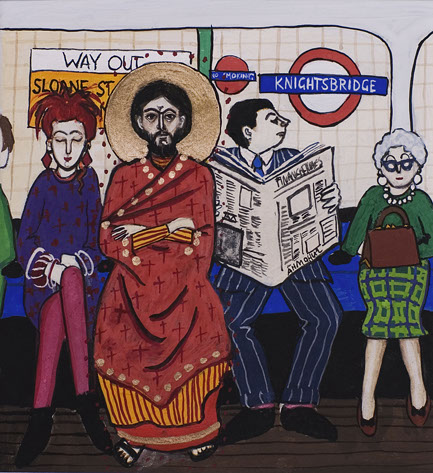They will join us on Sunday, too - along with the rest of the Jazz Ambassadors - for reflections on how jazz encourages peace-making. As I watched the children today - and thought about our experiences over the past two years - it is clear to me that jazz creates a way for many types of people to come together in the same space. Like brother Sly used to say: there's a beat for people who need that... and a bottom and some funk... a little bit of guitar, horns and a whole lotta melody and improvisation, too.
As I was driving home in the autumn sun I was touched by how blessed I have been by making jazz in a peace-making groove. We are able to make beautiful music and share it as a peace offering filled with love. And when that happens both the musicians in the band and the gathered audiences get to respond to that offering. More often than not, whenever an open heart is part of music well-played, people can't help but respond by sharing a little bit of love in return - and that is the core of peace-making for me.
I shared these words with my congregation yesterday in my weekly email - and they resonate with my jazz experience:
At midday Eucharist this week, we paused in reflection over this portion of the Sermon on the Mount as recorded in Matthew 5: Let me tell you why you are here. You’re here to be salt-seasoning that brings out the God-flavors of this earth. If you lose your saltiness, how will people taste godliness? You’ve lost your usefulness and will end up in the garbage.
After a time of silence, one person said, "If salt enhances, preserves and adds flavor to what nourishes us... isn't Jesus speaking about how we have been called to live in ways that encourage... beauty in our world?" This insight led our small group into a rich conversation about the different ways Christ has called us to nourish beauty in a broken world.
Worship is certainly a key place where beauty is nourished, created and shared in our tradition. Visually the sanctuary itself makes this point as our setting moves well past utilitarian concerns. The music and poetry of the liturgy, too evoke the beauty in our commitment to the grace of God. Candles, visual art and even the presence of lively attired people deepen our pursuit of beauty in worship. And the hope and prayer of liturgy is always that what we begin in the sanctuary goes with us into our streets and homes and places of work where we are invited to creatively give shape to all that is true, beautiful, pure and holy. In other words, beauty is not merely for decoration, it is both food for the soul and a unique form of ministry.
This Sunday, for example, Carlton has selected an anthem shaped by the hymn "For the Beauty of the Earth." It begins by honoring the beauty of God's presence in creation - the beauty of the earth, the glory of the skies - and moves on to celebrate music and art, the varieties of human love, culture and the blessings of grace. As the painter, Mako Fujimura, has noted, "God has placed primordial humanity in a world that will only reach its full potential for beauty when it is cultivated an explored - because there is always more goodness to be unearthed." That is part of what the story of the Garden of Eden suggests - cultivation - and continues through the Eucharist itself where grain and grapes are transformed into food and drink. "Bread and wine - not grain and grapes - are what Jesus raises up... and bread and wine are culture, not just nature. They are good for food and a delight to the eyes."
The Church used to know this - think of all the incredible music, art, poetry, dance, sculpture and prayer - that has come to birth through the Church. But, as Steve Turner, has written, "When TIME magazine compiled a list of the one hundred most significant people in 20th century art and entertainment, there were only five who had shown any public signs of Christian faith." What's more, as Frank Burch Brown, has observed: "A case could be made that ever since the early 19th century - if not before - much of the finest art and music of spiritual and theological import - whether popular or highly cultivated - has been created without the Church's blessing or, indeed, the Church's knowledge."
If you are in town, come on out to Dottie's on North Street tonight @ 7 pm. Or stop by worship on Sunday @ 10:30 am and check it out. The blessings abound!







1 comment:
I need to get more educated on church history (which will come in its own time) but the sense I've got is that when the (Protestant) church disengaged from art and music and all that, they had reasons which must have seemed to be good ones at the time -- maybe a sense that people were turning art into God?
But we've had a couple hundred years to sit with this, and what I think I'm seeing is that search for the spiritual, the holy even, chasing after art and music and nature, and those things turning out to be where God is (and likely was all along.)
So looking at the challenge of how to encourage unaffiliated people to check out (and hopefully find a home in) the church of their choosing - maybe for some of those people the answer is find the God that's out there, in the art, in the music, in the world, and bring that expression of God, that means of access to God, into the churches with them.
Post a Comment